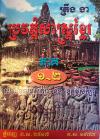
Troeung Ngea ត្រឹង ងា
Phnom Penh, Ministry of Education, Youth and Sports, 2003
Reviewed by Theara Thun (PhD Candidate, HYI-NUS Joint Doctoral Scholar)
The book is a republication of a two-volume work by Troeung Ngea, who taught literature, culture, and history at the Phnom Penh University [1] during Cambodia’s Republican period (1970-1975). The first volume was originally entitled Khmer [2] History: From the Beginning until the Abandonment of Angkor Capital, published in 1973. A year later, the second volume came out with the tittle, Khmer History: From the Establishment of Chaktomouk Capital until the Reign of King Sisowath. The book has been extremely popular and is one of the few Khmer-language books that broadly covers Cambodia’s historical development.
Using a chronological framework to structure his book, the author demarcates historical periods based on major events. With a total of fourteen chapters, the book begins with a brief overview of geography and the origins of the Khmer-Mon ethnicity. Troeung Ngea discusses Cambodia’s history in the early centuries by incorporating some pre-historical background, the spread of Indian civilization to Southeast Asia, and the sources for writing Cambodian history. Moving to the examination of Cambodian dynastic history, the author limited his discussions within different periods, namely Funan (first-sixth centuries), Chenla (sixth-ninth centuries), and Angkor (ninth-fifteenth centuries). He associated the fall of Angkor civilization with ongoing disputes among the ruling royal family together with the invasions and interference of Siamese states. While trying to map out Khmer civilization during the post-Angkor period (roughly between the fifteenth century and 1863), the book is virtually occupied with issues related to domestic crises, Siamese and Vietnamese invasions and interferences, and the arrival of French colonization in 1863. Although the author devotes his last chapter discussing Cambodia’s circumstances under the colonial rule, he ends his study at the end of the reign of King Sisowath Monivong in 1941, leaving the following reign of King Sihanouk (1941-1955) untouched.
My appreciation for the book stems from three major points. First, Troeung Ngea’s Khmer History is actually one of the most detailed and structural studies on Cambodian history that post-independent Cambodian scholars had ever produced. Incorporating a wide range of sources available at his time (1974), the author provided the most updated perspectives on different historical periods by integrating other scholars’ ideas into his own examinations. Second, besides illustrating stories surrounding kings and battles, the author pushed quite deep into the themes of cultural history. His examination on the origins of Khmer civilization (chapter 3 and 4), Angkor civilization (chapter 8), and post-Angkor civilization (chapter 11) are outstanding and hardly seen in any other colonial and post-colonial scholarship. Third, the book itself is historically significant as part of Cambodian intellectual history. It can be seen as a reflection of how Cambodian intellectuals perceived the craft of historical writing as introduced by French colonial scholars. Throughout the chapters, we can see how post-independent scholar Troeung Ngea adapted, revised, and even challenged colonial scholarship and made his narratives suit the Republican regime’s political agenda and needs.
However, there are some issues in the book that readers should be cautious about.. Like other master narratives of the nation, Troeung Ngea’s work pretty much characterizes a new version of the national history in favor of Lon Nol’s Republican regime, which ousted Prince Sihanouk, the-prince-who-used-to-be-king, from power in March 1970. The author’s examination of some historical aspects like the peasant rebellion, which marks the end of the Angkor dynasty in the 15th century (page 103-105), sounds rather like a plot targeted against Prince Sihanouk. Additionally, the author’s assessments on issues such as the split into two states of the Chenla kingdom [3] in the early eighth century (page 69-73) and the abandonment of Angkor capital in 1431 (page 107) have been criticized for lacking historical evidence. A study of David Chandler has revealed that during the fifteenth century, the region of Angkor was still quite heavily populated and several buildings in the region were restored. [4] Therefore, Troeung Ngea’s assertion about the abandonment of the capital in 1431 is put into a big question. My last observation touches upon the book’s lack of insights from external perspectives. The author appears to put too much effort into exposing Cambodian position within the conflict zone between neighboring Siam and Vietnam, and he overlooked broader regional factors, essentially regional trade networks, that also played an influential role in shaping Cambodia’s political and economic conditions during the 16th and 17th centuries.
After some forty years of circulating among Cambodian public, Khmer History has still remained one of the most influential and popular history textbooks, which can be found in many bookstores and libraries across Phnom Penh and other major towns throughout the country.
[1] It is Cambodia’s largest public university, originally named the Royal Khmer University, found in 1960. After the establishment of the Khmer Republic in 1970, the university’s name was changed to the Phnom Penh University. After closing down for some years during the civil war, the university became the Royal University of Phnom Penh, which still remains the largest and best university of the country.
[2] While the term “Khmer” represents an ethnic, a culture, and a language, “Cambodian” is more judicial and historical. After the Republicans, who greatly emphasized the supremacy of Mon-Khmer ethnic groups, seized power in 1970, they prohibited the term “Cambodian”, in favor of the use of “Khmer” for both the people and country.
[3] To learn more about new assessments on the Chenla period, please read: Michael Vickery. Society, Economics, and Politics in Pre-Angkor Cambodia: the 7th-8th centuries. Tokyo: The Toyo Bunko, 1998.
[4] David Chandler. A Short History of Cambodia. Colorado: Westview Press, 2008. pp. 92-93
